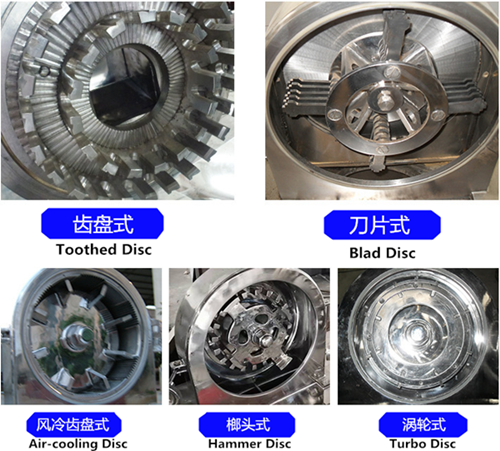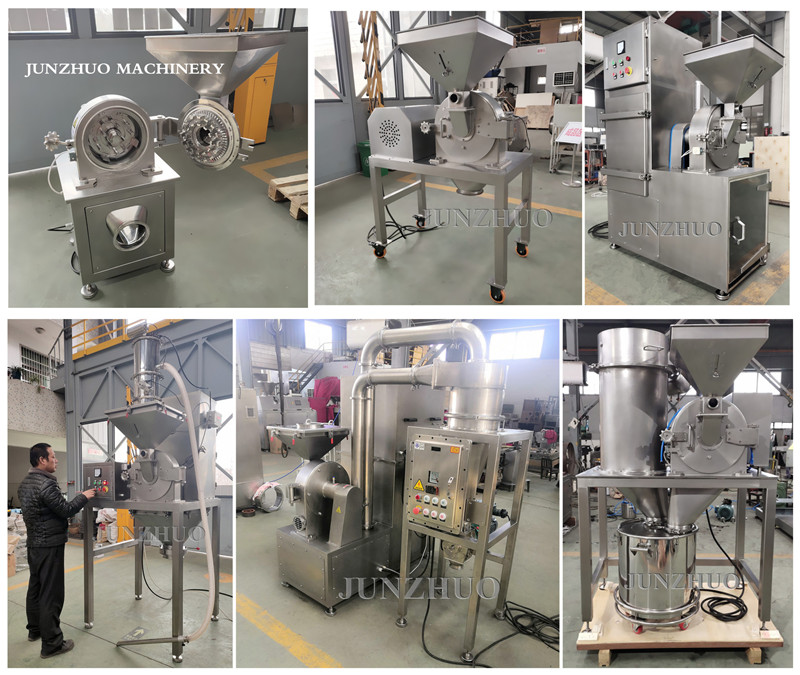Copyright © 2019 JIANGYIN JUNZHUO MACHINERY MANUFACTURING CO., LTD All Rights Reserved. Site MapDesigned by iwonder.cn
 jz@junzhuojx.com
jz@junzhuojx.com
 +86-0510-86382380
+86-0510-86382380

I. Comparative Summary Table
Characteristic Dimension | Hammer Type (Mallet) | Tooth Disc Type | Turbo Type | Blade Type |
Core Components | High-speed swinging movable hammers (mallets) | Toothed fixed and rotating discs | High-speed rotating turbine blades & classifier | High-speed rotating blades |
Working Principle | Impact, hammering | Shearing, collision, grinding | High-speed impact + airflow classification | Cutting, shearing |
Main Advantages | Strong versatility, high crushing force | Good fineness, compact structure | Ultra-high fineness, high efficiency, low temperature rise | Excellent for soft, fibrous, tough materials |
Main Disadvantages | Uneven fineness, high temperature rise, easy screen clogging | Not suitable for ultra-hard or tough materials | Complex structure, high cost, material limitations | Cannot handle hard materials, easy wear |
Applicable Materials | Broad spectrum, medium hardness (grains, Chinese herbal medicines, feed) | Brittle, medium hardness (most Chinese herbal medicines, chemical raw materials) | Low-hardness brittle materials requiring high fineness (high-value medicinal powders, cosmetics, food additives) | Fibrous, tough, soft (plant branches/leaves, plastics, food, fruits/vegetables) |
Discharge Method | Screen-controlled fineness | Screen-controlled fineness | Classifier-controlled fineness (screenless) | Screen-controlled fineness |
II. Detailed Interpretation
1. Hammer Type (Mallet) - "The Powerful Hammer"
Working Method: The rotor drives multiple swingable hammer blades to rotate at high speed. When materials enter, they are shattered by the violent impact of the hammer blades, and particles smaller than the screen aperture are discharged.
Characteristics:
Advantages: Strong impact force, wide applicability, relatively simple structure, low cost.
Disadvantages: Relatively low crushing efficiency; discharge relies on screens (prone to clogging and heating); uneven particle size distribution (mixed coarse/fine powder) with low fine powder extraction rate.
Analogy: Like a craftsman with a sledgehammer, breaking things with brute force.
2. Tooth Disc Type - "Grindstone & Sharp Teeth"
Working Method: Consists of a high-speed rotating movable toothed disc and a fixed stationary toothed disc, with interlocking tooth rings. Materials are crushed by the combined action of shearing, collision, and friction between the discs.
Characteristics:
Advantages: Stronger shearing force than pure hammer type, better fineness, more uniform particle size; compact structure (the most common design for "universal crushers").
Disadvantages: Less effective for extremely hard or flexible materials.
Analogy: Like two interlocking toothed grindstones grinding against each other.
3. Turbo Type - "Ultra-High-Speed Cyclone"
Working Method: A typical structure for high-efficiency/ultrafine crushers. Materials are sucked in and crushed by the ultra-high-speed impact of turbine blades. The crushed powder is blown upward to the classifier, which acts like a high-speed rotating mesh wheel—only sufficiently fine powder passes through, while coarse particles are thrown back to the crushing zone for further processing.
Characteristics:
Advantages:
Screenless: Completely eliminates clogging issues.
Ultra-high and adjustable fineness: Precisely control product fineness (up to 300+ mesh, micron level) by adjusting classifier speed.
High efficiency, low temperature rise: Continuous operation with excellent air cooling—suitable for heat-sensitive materials.
Disadvantages: Complex structure, high manufacturing cost, typically optimized for specific material properties.
Analogy: Like a powerful "industrial vacuum cleaner + cyclone separator"—sucking in particles and blowing out ultra-fine powder.
4. Blade Type - "The Sharp Blade"
Working Method: The rotor drives several sharp blades to rotate at high speed, crushing materials via cutting, chopping, and shearing.
Characteristics:
Advantages: Ideal for fibrous, tough, soft materials with high cutting efficiency.
Disadvantages: Low crushing force (cannot handle hard materials); blade edges wear easily and require frequent sharpening or replacement.
Analogy: Like a high-speed rotating "food processor" or "meat grinder," specialized in chopping.
Summary & Selection Guide
For handling diverse common materials (e.g., various Chinese herbal medicines, grains, feed): Choose tooth disc or hammer type universal crushers for the best cost-performance ratio.
For pursuing extreme fineness and high efficiency with high-value materials (e.g., producing high-end medicinal powders, cosmetic raw materials): Select turbo type high-efficiency crushers.
For primarily processing soft/tough materials like plant fibers, plastics, or food ingredients: Blade type crushers deliver better results.
By continuing to use the site you agree to our privacy policy Terms and Conditions.